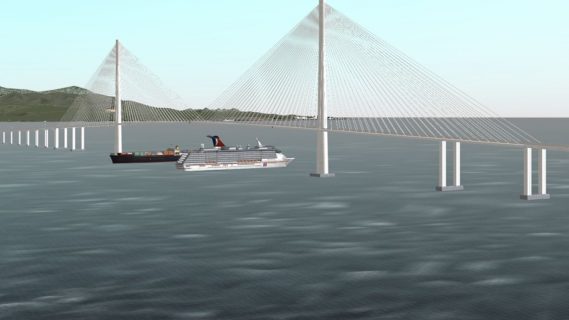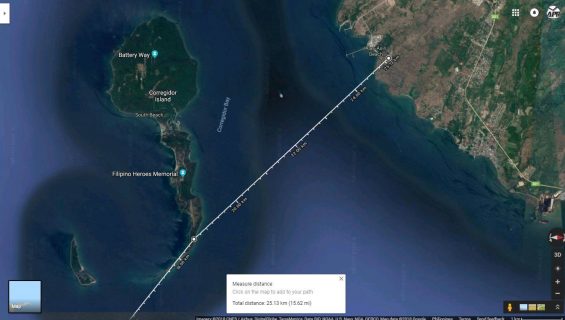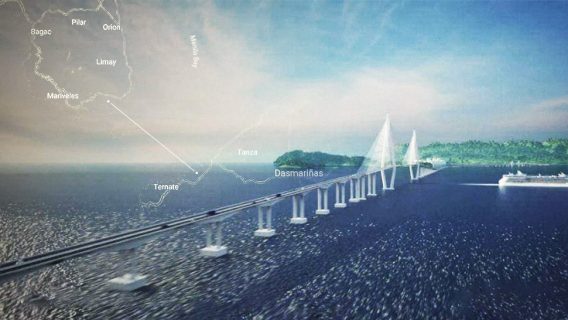Bataan-Cavite Interlink Bridge (BCIB) Project is an infrastructure project developed by the Government of the Republic of the Philippines through the Department of Public Works and Highways (DPWH), under the government’s Build, Build, and Build (BBB) program whose objective is to boost the Southeast Asia country’s economic growth through increased investments in public infrastructure.
The approximately US$ 3.6bn involves the construction of a 32.15 kilometers-long cable-stayed bridge spanning from Barangay Alas-asin in Mariveles, Bataan crossing Manila Bay and ending in Barangay Timalan, Naic, Cavite.
Also Read: Padma Multipurpose Bridge project timeline and all you need to know
The bridge project is made up of marine viaducts, dubbed the North Channel viaduct (12.6 km) and the South Channel viaduct (8.0 km), each with two lanes. The North Channel viaduct has a main span of 400m while the South Channel viaduct has a main span of 900m. Both viaducts stand at a water depth of approximately 50m.

Other components of the project include approach viaducts to Northern and Southern navigation channel bridges (2.6 km), Bataan land viaduct (5.04 km), navigation channel bridges (2.6 km), Cavite land viaduct (1.31 km), and ancillary buildings.
After getting to the Corregidor, the bridge will transition into a tunnel and leave the surface of the historic island, allowing for the development of a stopover from the high-speed train for easy access.
Upon completion, the Bataan-Cavite Interlink Bridge (BCIB) is expected to be the largest of its kind in the country. It will reduce travel time from Bataan to Cavite to 40 minutes from 5 hours and significantly ease traffic on the North Luzon Expressway, which is currently the main thoroughfare to provinces north of Metro Manila.
The bridge will also help to transform the regional economies of Cavite, Bataan, and provinces located further north of Bataan through improved connectivity, new economic opportunities, and jobs. Furthermore, it will provide opportunities for new expansion and economic growth outside Manila for example the development of seaports in Cavite and Bataan as major international shipping gateways to the Philippines.

Bataan-Cavite Interlink Bridge (BCIB) Project timeline
2019
In December 2019, the Asian Development Bank (ADB) approved a US$ 200m loan as additional financing for the infrastructure preparation and innovation facility for the project and announced that it was preparing to support the financing for the construction of the project in 2022.
2020
In January 2020, the National Economic Development Authority (NEDA) Board, which reviews big-ticket projects in Philippines, approved the Bataan-Cavite Interlink Bridge project, citing its potential to reduce road congestion in Metro Manila.
In October 2020 DPWH signed a US$ 59m deal with a joint venture of T.Y. Lin International and Pyunghwa Engineering Consultants, along with DCCD Engineering Corporation and Renardet for provision of detailed engineering design (DED) of the Bataan-Cavite Interlink Bridge (BCIB) project.
Ove Arup & Partners, was appointed as consultant for DPWH for this project. The company commissioned the Maritime Academy of Asia and the Pacific (MAAP) for the design, development, and execution of the required simulation exercises to understand the maneuverability of simulated vessels along the proposed navigation channel beneath the bridge.

April 2023
Construction of Bataan-Cavite bridge may start early 2024
The Department of Public Works and Highways (DPWH) plans to begin constructing the Bataan-Cavite Interlink Bridge (BCIB) in early 2024. The bridge, spanning 32.15 kilometers with four lanes, will connect Barangay Alas-asin in Mariveles, Bataan, to Barangay Timalan Concepcion in Naic, Cavite.
The project aims to reduce travel time from five hours to approximately 45 minutes. Teresita Bauzon, the DPWH project manager, expressed hope that packages 1 and 2 of the construction could start this year, with the remaining packages procured by next year.
The entire construction process is anticipated to conclude by mid-2028.
Funding for the BCIB will come from loans provided by the Asian Development Bank (ADB) and Asian Infrastructure Investment Bank. Negotiations between the National Economic Development Authority, ADB, and other parties involved are ongoing to secure the funding for the project.
President Ferdinand R. Marcos Jr. recently led a milestone ceremony for the detailed engineering design of the BCIB. He urged DPWH officials, employees, and consultants to remain committed to completing the bridge according to the schedule. The feasibility study for the project began in March 2018 and was financed by an ADB loan from the Infrastructure Preparation and Innovation Facility.


Who are the Philippine Construction companies who won the bidding for this project?
Can a well detailed map be posted. So far everything I find is rather vague.
Is this project started already? If it is, how many percent completed already?
Wishing to work this wonderful project of my country, cable stay bridge planning management